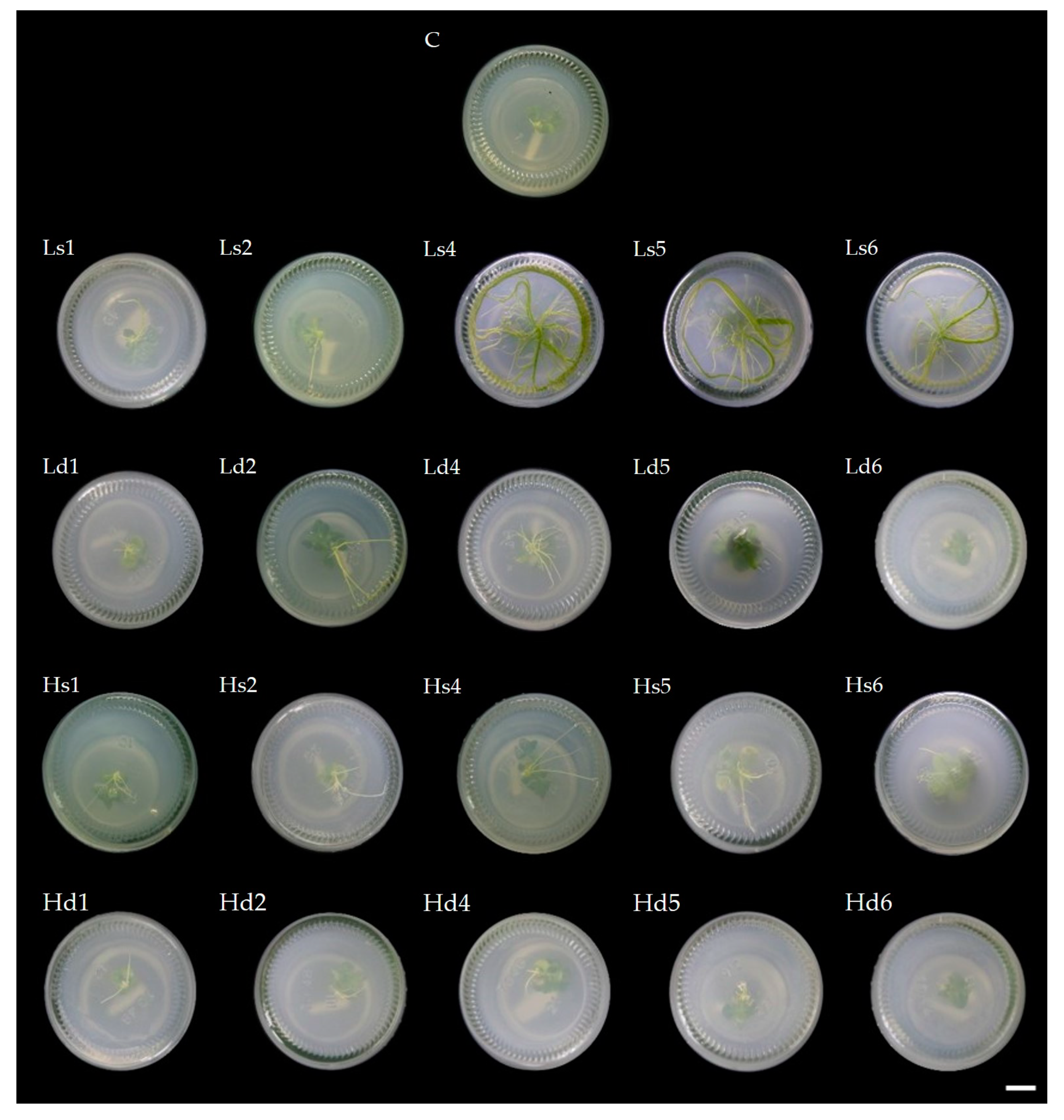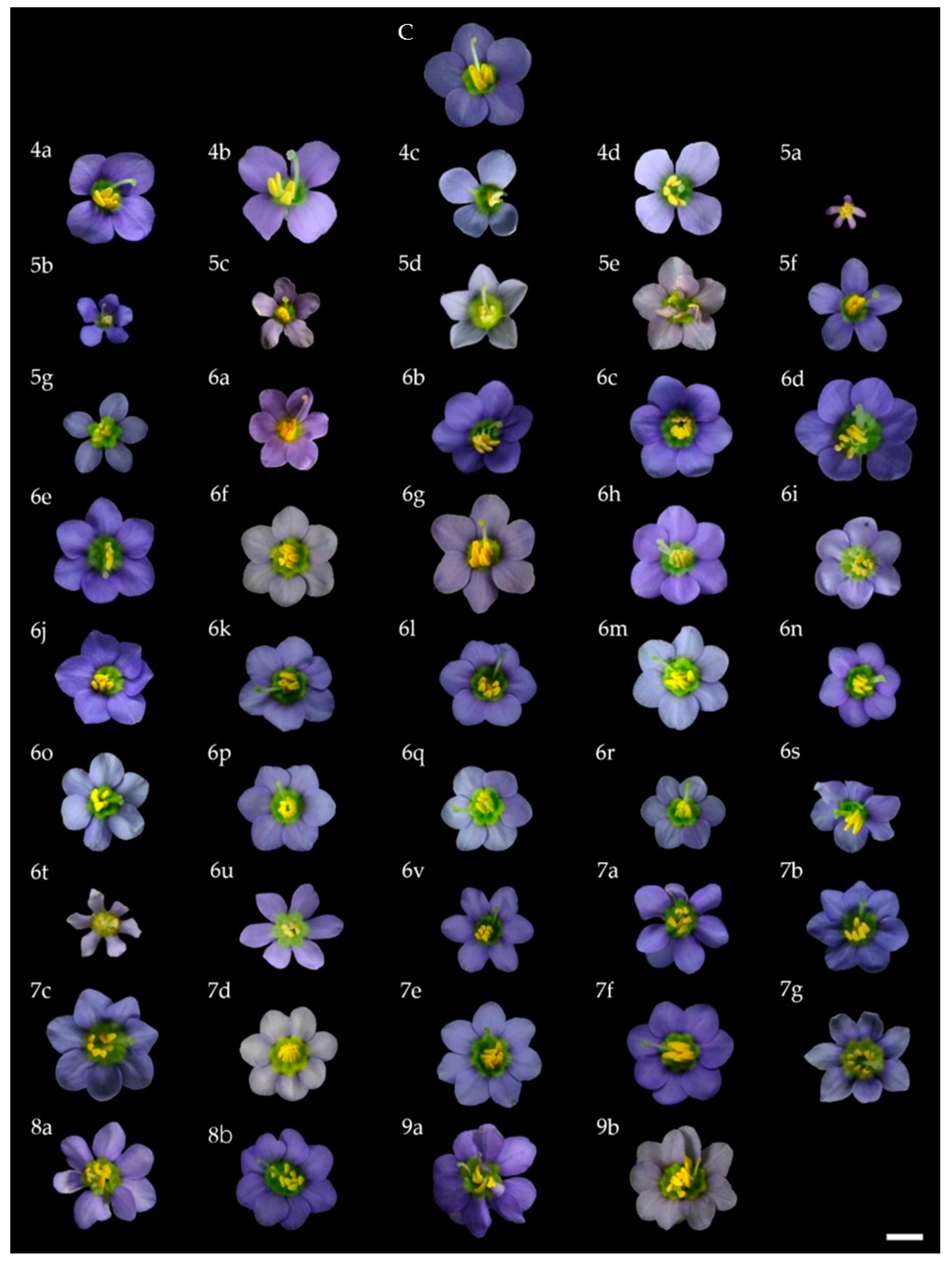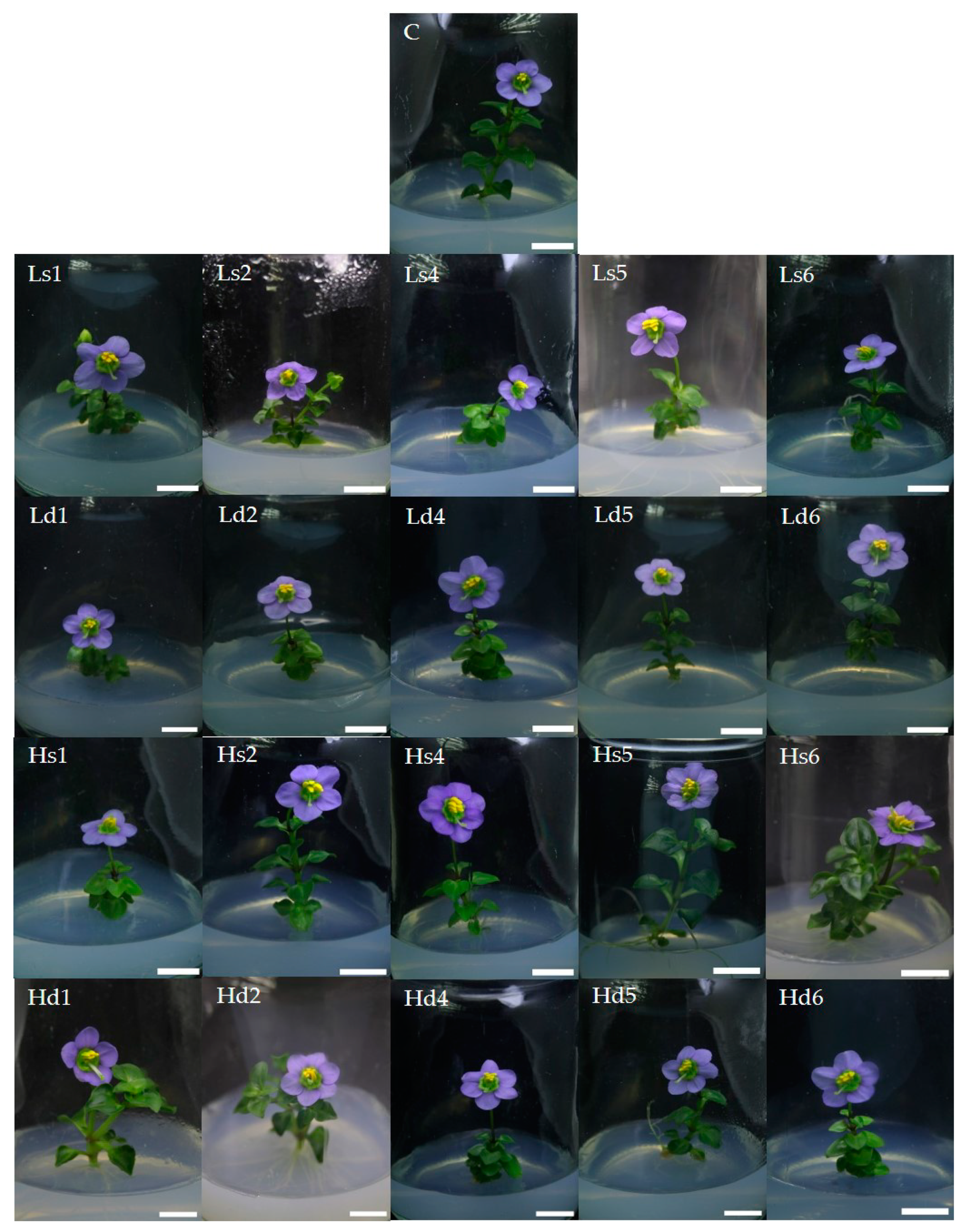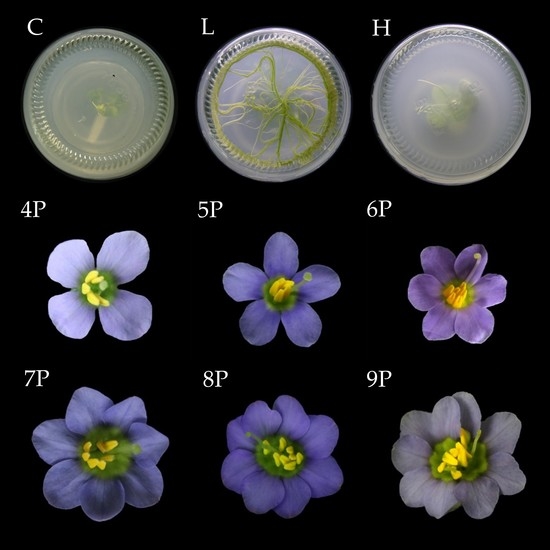Differing In Vitro Rooting and Flowering Responses of the Persian Violet to Low and High UV-C Irradiation
Abstract
1. Introduction
2. Results
2.1. UV-C Induced Persian Violet Root In Vitro
2.2. UV-C Induced In Vitro Mutation of the Persian Violet Flower
3. Discussion
3.1. Plantlet Establishment
3.2. In Vitro Persian Violet Root Initiation
3.3. In Vitro Persian Violet Flower Mutation
4. Materials and Methods
4.1. Plant Materials
4.2. In Vitro Persian Violet Root Initiation
4.3. In Vitro Mutation of the Persian Violet Flower
4.4. Statistical Analysis
5. Conclusions
Supplementary Materials
Author Contributions
Funding
Institutional Review Board Statement
Informed Consent Statement
Data Availability Statement
Conflicts of Interest
References
- Iliev, I.; Gajdosova, A.; Libiakova, G.; Jain, S.M. Plant micropropagation. In Plant Cell Culture, Essential Methods; Davey, M.R., Anthony, P., Eds.; John Wiley & Sons, Ltd.: West Sussex, UK, 2010; pp. 1–23. [Google Scholar]
- Park, H.Y.; Kim, D.H.; Sivanesan, I. Micropropagation of Ajuga species: A mini review. Biotechnol. Lett. 2017, 39, 1291–1298. [Google Scholar] [CrossRef]
- Ambrožič-Dolinšek, J.; Ciringer, T.; Kaligarič, M. Micropropagation of the narrow endemic Hladnikia pastinacifolia (Apiaceae). Acta Bot. Croat. 2016, 75, 244–252. [Google Scholar] [CrossRef]
- Zahid, N.A.; Jaafar, H.Z.E.; Hakiman, M. Micropropagation of ginger (Zingiber officinale Roscoe) ‘Bentong’ and evaluation of its secondary metabolites and antioxidant activities compared with the conventionally propagated plant. Plants 2021, 10, 630. [Google Scholar] [CrossRef] [PubMed]
- Harahap, F.; Poerwanto, R.; Suharsono; Suriani, C.; Rahayu, S. In vitro growth and rooting of mangosteen (Garcinia mangostanaL) on medium with different concentrations of plant growth regulator. HAYATI J. Biosci. 2014, 21, 151–158. [Google Scholar] [CrossRef]
- Thomas, T.D. The role of activated charcoal in plant tissue culture. Biotechnol. Adv. 2008, 26, 618–631. [Google Scholar] [CrossRef] [PubMed]
- Bodhipadma, K.; Noichinda, S.; Luangsriumporn, P.; Meenapa, C.; Nathalang, K.; Leung, D.W.M. Ginger juice enhanced growth of aromatic chilli during in vitro culture and acclimatization. J. Appl. Horticult. 2012, 14, 88–91. [Google Scholar] [CrossRef]
- Çelik, Ö.; Atak, Ç. Applications of ionizing radiation in mutation breeding. In New Insights on Gamma Rays; Maghraby, A.M., Ed.; IntechOpen: London, UK, 2017; pp. 111–132. [Google Scholar]
- Ramakrishna, D.; Chaitanya, G.; Suvarchala, V.; Shasthree, T. Effect of gamma ray irradiation and ethyl methane sulphonate on in vitro mutagenesis of Citrullus colocynthis (L.) Schrad. J. Plant Biotechnol. 2018, 45, 55–62. [Google Scholar] [CrossRef]
- Ehsanpour, A.A.; Razavizadeh, R. Effect of UV-C radiation on drought tolerance of alfalfa (Medicago sativa) callus. Pak. J. Biol. Sci. 2005, 8, 1221–1224. [Google Scholar]
- Cetin, E.S. Induction of secondary metabolite production by UV-C radiation in Vitis vinifera L. Öküzgözü callus cultures. Biol. Res. 2014, 47, 37. [Google Scholar] [CrossRef]
- Petchang, R. Effect of UV-C irradiation on antioxidant activities: Total phenolic and flavonoid contents and quantitative determination of bioactive components of Moringa oleifera Lam. shoot culture. Afr. J. Biotechnol. 2014, 13, 4093–4099. [Google Scholar]
- Ehsanpour, A.A.; Madani, S.; Hoseini, H. Detection of somaclonal variation in potato callus induced by UV-C radiation using RAPD-PCR. Gen. Appl. Plant Physiol. 2007, 33, 3–11. [Google Scholar]
- Murashige, T.; Skoog, F. A revised medium for rapid growth and bio assays with tobacco tissue cultures. Physiol. Plant. 1962, 15, 473–497. [Google Scholar] [CrossRef]
- Limtiyayotin, M.; Tosri, C.; Sukin, N.; Jompuk, P. Effects of acute gamma irradiation on in vitro culture of Exacum affine Balf.f. ex Regel. Agric. Nat. Resour. 2018, 52, 121–124. [Google Scholar] [CrossRef]
- Sarai, N.; Bodhipadma, K.; Noichinda, S.; Luangsriumporn, P.; Leung, D.W.M. Microshoot culture of Persian violet: Plant regeneration and in vitro flowering. Ann. Agric. Sci. 2017, 62, 105–111. [Google Scholar] [CrossRef]
- Sukthavornthum, W.; Bodhipadma, K.; Noichinda, S.; Phanomchai, S.; Deelueak, U.; Kachonpadungkitti, Y.; Leung, D.W.M. UV-C irradiation induced alterations in shoot proliferation and in vitro flowering in plantlets developed from encapsulated and non-encapsulated microshoots of Persian violet. Sci. Hortic. 2018, 233, 9–13. [Google Scholar] [CrossRef]
- Mantovska, D.I.; Zhiponova, M.K.; Georgiev, M.I.; Grozdanova, T.; Gerginova, D.; Alipieva, K.; Simova, S.; Popova, M.; Kapchina-Toteva, V.M.; Yordanova, Z.P. In vitro multiplication and NMR fingerprinting of rare Veronica caucasica M. Bieb. Molecules 2021, 26, 5888. [Google Scholar] [CrossRef]
- Chaipanich, V.V.; Roberts, D.L.; Yenchon, S.; Te-chato, S.; Divakaran, M. In vitro seed germination and plantlet regeneration of Vanilla siamensis: An endemic species in Thailand. ScienceAsia 2020, 46, 315–322. [Google Scholar] [CrossRef]
- Antonopoulou, C.; Dimassi, K.; Therios, I.; Chatzissavvidis, C. The influence of radiation quality on the in vitro rooting and nutrient concentrations of peach rootstock. Biol. Plant. 2004, 48, 549–553. [Google Scholar] [CrossRef]
- Abou Dahab, A.M.; Heikal, A.A.M.; Taha, L.S.; Gabr, A.M.M.; Metwally, S.A.; Ali, A.A.R. In vitro mutagenesis induction in Eustoma grandiflorum plant using gamma radiation. J. Environ. Sci. Technol. 2017, 10, 175–185. [Google Scholar] [CrossRef][Green Version]
- Abou-Dahab, A.D.M.; Mohammed, T.A.; Heikal, A.A.; Taha, L.S.; Gabr, A.M.M.; Metwally, S.A.; Ali, A.I.R. In vitro laser radiation induces mutation and growth in Eustoma grandiflorum plant. Bull. Natl. Res. Cent. 2019, 43, 3. [Google Scholar] [CrossRef]
- Bridgen, M. Using ultraviolet-C light as a plant growth regulator. Acta Hortic. 2015, 1085, 167–169. [Google Scholar] [CrossRef]
- Bridgen, M.P. Using ultraviolet-C (UV-C) irradiation on greenhouse ornamental plants for growth regulation. Acta Hortic. 2016, 1134, 49–56. [Google Scholar] [CrossRef]
- Katerova, Z.; Todorova, D. Effect of enhanced UV-C irradiation on the growth, malondialdehyde, hydrogen peroxide, free proline, polyamines, IAA and IAA-oxidase activity in pea plants (Pisum sativum L.). Compt. Rend. Acad. Bulg. Sci. 2011, 64, 1555–1562. [Google Scholar]
- Kobashigawa, C.; Tamaya, K.; Shimomachi, T. Effect of UV-C treatment on plant growth and nutrient contents. Acta Hortic. 2011, 907, 237–242. [Google Scholar] [CrossRef]
- Castronuovo, D.; Tataranni, G.; Lovelli, S.; Candido, V.; Sofo, A.; Scopa, A. UV-C irradiation effects on young tomato plants: Preliminary results. Pak. J. Bot. 2014, 46, 945–949. [Google Scholar]
- Loconsole, D.; Santamaria, P. UV lighting in horticulture: A sustainable tool for improving production quality and food safety. Horticulturae 2021, 7, 9. [Google Scholar] [CrossRef]
- Lamseejan, S.; Jompuk, P.; Wongpiyasatid, A.; Deeseepan, S.; Kwanthammachart, P. Gamma-rays induced morphological changes in chrysanthemum. (Chrysanthemum morifolium). Kasetsart J. (Nat. Sci.) 2000, 34, 417–422. [Google Scholar]
- Dai, W.H.; Magnusson, V. Morphological variations in Buddleia induced by gamma ray irradiation. HortScience 2012, 47, 81–83. [Google Scholar] [CrossRef]
- Abdulhafiz, F.; Kayat, F.; Zakaria, S. Effect of gamma irradiation on the morphological and physiological variation from in vitro individual shoot of banana cv. Tanduk (Musa spp.). J. Plant Biotechnol. 2018, 45, 140–145. [Google Scholar] [CrossRef]
- Masae, N.; Yunuh, R.; Usoof, H.; Samala, S. Induced mutation in Persian violet by ultraviolet C radiation. Songklanakarin J. Plant Sci. 2014, 1, 27–30. [Google Scholar]
- Darras, A.I.; Tsikaloudakis, G.; Lycoskoufis, I.; Dimitriadis, C.; Karamousantas, D. Low doses of UV-C irradiation affects growth, fruit yield and photosynthetic activity of tomato plants. Sci. Hortic. 2020, 267, 109357. [Google Scholar] [CrossRef]



| Light Intensity | No. of Irradiations | Duration (h) | Shoot Number | Shoot Height (cm) | Root Number | Root Length (cm) |
|---|---|---|---|---|---|---|
| Control | - | - | 1.1 ± 0.2 c | 1.6 ± 0.1 cd | 0.2 ± 0.4 f | 0.04 ± 0.1 h |
| Low | single | 1 | 1.0 ± 0.0 c | 1.5 ± 0.7 cde | 1.2 ± 1.1 bc | 1.6 ± 1.8 de |
| 2 | 1.0 ± 0.0 c | 1.8 ± 0.4 c | 1.4 ± 1.3 b | 1.6 ± 1.8 de | ||
| 4 | 1.4 ± 0.9 a | 3.5 ± 0.6 a | 3.1 ± 1.0 a | 9.3 ± 1.8 a | ||
| 5 | 1.1 ± 0.2 ab | 3.2 ± 0.4 ab | 2.7 ± 1.0 a | 7.3 ± 1.3 b | ||
| 6 | 1.5 ± 0.7 a | 3.2 ± 0.7 b | 2.8 ± 0.8 a | 6.3 ± 1.0 c | ||
| double | 1 | 1.1 ± 0.3 c | 1.0 ± 0.7 gf | 1.1 ± 0.8 bcd | 0.7 ± 0.6 fgh | |
| 2 | 1.2 ± 0.4 c | 1.8 ± 0.8 c | 1.5 ± 1.1 b | 2.9 ± 1.7 d | ||
| 4 | 1.4 ± 0.6 c | 1.2 ± 0.3 ef | 1.2 ± 0.5 bc | 1.5 ± 1.4 de | ||
| 5 | 1.1 ± 0.3 c | 1.0 ± 0.6 gf | 0.9 ± 0.8 bcd | 1.3 ± 1.3 def | ||
| 6 | 1.0 ± 0.0 c | 0.8 ± 0.5 gh | 0.5 ± 0.8 de | 0.4 ± 0.6 gh | ||
| High | single | 1 | 1.0 ± 0.0 c | 1.1 ± 0.3 gf | 1.0 ± 1.0 bcd | 1.4 ± 1.3 def |
| 2 | 1.0 ± 0.0 c | 1.2 ± 0.6 gf | 1.4 ± 1.0 b | 1.9 ± 0.7 e | ||
| 4 | 1.0 ± 0.0 c | 1.3 ± 0.8 def | 1.2 ± 0.5 bc | 2.9 ± 0.5 d | ||
| 5 | 1.1 ± 0.4 c | 1.6 ± 0.8 cd | 1.2 ± 1.0 bc | 1.7 ± 1.5 e | ||
| 6 | 1.0 ± 0.0 c | 1.3 ± 0.3 def | 1.1 ± 0.8 cd | 1.3 ± 0.9 def | ||
| double | 1 | 1.1 ± 0.3 c | 1.3 ± 0.7 def | 0.7 ± 0.6 cde | 0.8 ± 0.8 efg | |
| 2 | 1.1 ± 0.2 c | 1.4 ± 0.4 def | 1.1 ± 0.6 bcd | 0.9 ± 0.5 efg | ||
| 4 | 1.0 ± 0.0 c | 1.2 ± 0.3 gf | 1.1 ± 0.8 bcd | 0.7 ± 0.6 fgh | ||
| 5 | 1.0 ± 0.0 c | 1.1 ± 0.5 gf | 0.5 ± 1.0 de | 0.4 ± 0.7 gh | ||
| 6 | 1.0 ± 0.0 c | 0.6 ± 0.4 h | 0.2 ± 0.4 f | 0.04 ± 0.1 h |
| Code | Intensity | No. of Irradiations | Duration (h) | Floral Diameter (cm) | Petal No. and Flower Form | Petal Color (Violet- Blue Group) | No. of Anthers | Anther Color (Yellow- Orange Group) | Style Length (mm) |
|---|---|---|---|---|---|---|---|---|---|
| c | - | - | - | 0.8 ± 0.7 | 5, control | 93-B | 5 | 14-A | 4 |
| 4a | H | single | 6 | 1.4 | 4, standard | 93-B | 5 | 15-B | 4 |
| 4b | H | single | 5 | 1.5 | 4, irregular | 93-C | 4 | 14-A | 4 |
| 4c | H | single | 5 | 1.2 | 4, irregular | 93-C | 3 | 12-A | 2 |
| 4d | H | single | 5 | 1.4 | 4, irregular | 93-C | 5 | 14-A | 4 |
| 5a | H | single | 4 | 0.5 | 5, irregular | 93-B | 5 | 12-B | <2 |
| 5b | H | single | 5 | 0.8 | 5, irregular | 93-B | 5 | 14-A | 4 |
| 5c | H | single | 4 | 1.0 | 5, irregular | 93-B | 5 | 14-A | <2 |
| 5d | H | single | 4 | 1.2 | 5, irregular | 93-C | 5 | 12-B | 4 |
| 5e | H | single | 6 | 1.3 | 5, irregular | 93-C | 3 | 14-A | 2 |
| 5f | H | single | 6 | 1.3 | 5, irregular | 93-C | 5 | 14-A | 4 |
| 5g | H | single | 5 | 1.2 | 5, irregular | 93-C | 5 | 14-A | 2 |
| 6a | H | single | 6 | 1.2 | 6, standard | 93-B | 6 | 14-A | 4 |
| 6b | H | single | 6 | 1.4 | 6, standard | 93-B | 6 | 14-A | 4 |
| 6c | H | single | 6 | 1.4 | 6, standard | 93-B | 6 | 14-A | <2 |
| 6d | H | single | 6 | 1.5 | 6, standard | 93-B | 7 | 14-A | 3 |
| 6e | H | single | 5 | 1.4 | 6, standard | 93-B | 5 (2 nm and 3 ab) | 14-A | 2 |
| 6f | H | single | 5 | 1.4 | 6, standard | 93-C | 6 | 14-A | <2 |
| 6g | H | single | 5 | 1.5 | 6, standard | 93-C | 6 | 14-A | 4 |
| 6h | H | single | 5 | 1.4 | 6, standard | 93-B | 6 | 14-A | <2 (2 styles) |
| 6i | H | single | 5 | 1.3 | 6, standard | 93-C | 6 | 14-A | <2 |
| 6j | H | single | 5 | 1.3 | 6, standard | 93-B | 5 | 14-A | <2 |
| 6k | H | single | 4 | 1.3 | 6, standard | 93-C | 6 | 14-B | 4 |
| 6l | H | single | 4 | 1.3 | 6, standard | 93-B | 6 | 14-B | 4 |
| 6m | H | single | 4 | 1.4 | 6, standard | 93-C | 6 | 15-B | 4 |
| 6n | H | double | 2 | 1.2 | 6, standard | 93-B | 5 | 14-A | 4 |
| 6o | H | double | 4 | 1.3 | 6, standard | 94-C | 6 | 14-A | 2 |
| 6p | H | double | 5 | 1.3 | 6, standard | 94-B | 6 | 14-B | 4 |
| 6q | H | double | 5 | 1.2 | 6, standard | 94-C | 5 | 14-B | 4 |
| 6r | L | double | 4 | 1.1 | 6, standard | 94-C | 5 | 14-B | 4 |
| 6s | L | double | 5 | 1.3 | 6, standard | 93-B | 4 | 14-A | 2 |
| 6t | H | single | 4 | 1.3 | 6, irregular | 93-B | 6 | 14-A | 4 |
| 6u | H | single | 5 | 1.0 | 6, irregular | 94-C | 5 | 14-A | 3 |
| 6v | H | single | 5 | 1.4 | 6, irregular | 93-C | 6 | 14-A | <2 |
| 7a | H | single | 6 | 1.4 | 7, irregular | 93-B | 7 | 14-A | 2 |
| 7b | H | single | 6 | 1.3 | 7, standard | 93-B | 6 | 14-A | 3 |
| 7c | H | single | 5 | 1.5 | 7, standard | 94- B | 7 | 14-A | 3 |
| 7d | H | single | 4 | 1.2 | 7, standard | 94-C | 7 | 14-B | <2 |
| 7e | H | single | 4 | 1.4 | 7, standard | 94-C | 7 | 14-B | 4 |
| 7f | H | single | 4 | 1.4 | 7, standard | 93-B | 7 | 14-B | 4 |
| 7g | H | single | 4 | 1.4 | 7, irregular | 94-C | 7 | 14-A | 4 |
| 8a | H | single | 5 | 1.3 | 8, irregular | 93-B | 8 | 14-A | 2 |
| 8b | H | single | 5 | 1.3 | 8, standard | 93-B | 8 | 14-A | 4 (2 styles) |
| 9a | H | single | 6 | 1.4 | 9, irregular | 93-B | 3 | 14-A | 2 |
| 9b | H | single | 6 | 1.5 | 9, irregular | 94-C | 9 | 14-A | 2 |
| Light Intensity | No. of Irradiations | Duration (h) | Floral Size (cm) | Number of Flowers | Number of Petals | Shoot Height (cm) |
|---|---|---|---|---|---|---|
| Control | - | - | 0.8 ± 0.7 c | 0.6 ± 0.5 c | 2.9 ± 2.5 b | 2.3 ± 0.2 ef |
| Low | single | 1 | 0.7 ± 0.7 c | 0.6 ± 0.5 c | 2.8 ± 2.5 b | 2.2 ± 0.1 fg |
| 2 | 0.7 ± 0.7 c | 0.6 ± 0.5 c | 2.9 ± 2.5 b | 2.3 ± 0.2 ef | ||
| 4 | 0.8 ± 0.7 c | 0.6 ± 0.5 c | 3.0 ± 2.5 b | 4.1 ± 0.3 a | ||
| 5 | 0.8 ± 0.7 c | 0.6 ± 0.5 c | 2.9 ± 2.5 b | 4.0 ± 0.3 a | ||
| 6 | 0.7 ± 0.7 c | 0.6 ± 0.5 c | 2.8 ± 2.5 b | 3.8 ± 0.2 b | ||
| double | 1 | 0.9 ± 1.7 c | 0.5 ± 0.5 c | 2.7 ± 2.5 b | 2.1 ± 0.1 h | |
| 2 | 0.8 ± 0.7 c | 0.6 ± 0.5 c | 2.9 ± 2.5 b | 2.4 ± 0.2 e | ||
| 4 | 0.9 ± 0.7 bc | 0.6 ± 0.5 c | 3.2 ± 2.4 b | 2.3 ± 0.2 ef | ||
| 5 | 1.0 ± 1.8 bc | 0.6 ± 0.5 c | 3.2 ± 2.5 b | 2.2 ± 0.3 fg | ||
| 6 | 0.9 ± 0.6 bc | 0.7 ± 0.5 bc | 3.4 ± 2.4 b | 2.2 ± 0.3 gh | ||
| High | single | 1 | 0.8 ± 0.7 c | 0.6 ± 0.5 c | 3.0 ± 2.5 b | 2.2 ± 0.2 fg |
| 2 | 0.9 ± 0.6 bc | 0.7 ± 0.5 bc | 3.3 ± 2.4 b | 2.3 ± 0.2 efg | ||
| 4 | 1.1 ± 0.5 bc | 0.9 ± 0.3 b | 4.5 ± 1.9 a | 3.8 ± 0.4 b | ||
| 5 | 1.3 ± 0.3 ab | 1.0 ± 0.2 a | 5.1 ± 1.2 a | 3.8 ± 0.6 b | ||
| 6 | 1.6 ± 2.3 a | 0.9 ± 0.3 b | 4.9 ± 1.6 a | 3.7 ± 0.5 b | ||
| double | 1 | 0.9 ± 0.6 bc | 0.7 ± 0.5 bc | 3.6 ± 2.3 b | 2.4 ± 0.3 ef | |
| 2 | 0.9 ± 0.6 bc | 0.7 ± 0.5 bc | 3.4 ± 2.4 b | 3.4 ± 0.7 d | ||
| 4 | 1.1 ± 1.7 bc | 0.7 ± 0.5 bc | 3.5 ± 2.3 b | 3.6 ± 0.3 c | ||
| 5 | 0.9 ± 0.6 bc | 0.7 ± 0.5 bc | 3.6 ± 2.3 b | 3.7 ± 0.2 bc | ||
| 6 | 0.9 ± 0.6 bc | 0.7 ± 0.5 bc | 3.6 ± 2.3 b | 2.3 ± 0.4 ef |
Publisher’s Note: MDPI stays neutral with regard to jurisdictional claims in published maps and institutional affiliations. |
© 2021 by the authors. Licensee MDPI, Basel, Switzerland. This article is an open access article distributed under the terms and conditions of the Creative Commons Attribution (CC BY) license (https://creativecommons.org/licenses/by/4.0/).
Share and Cite
Phanomchai, S.; Noichinda, S.; Kachonpadungkitti, Y.; Bodhipadma, K. Differing In Vitro Rooting and Flowering Responses of the Persian Violet to Low and High UV-C Irradiation. Plants 2021, 10, 2671. https://doi.org/10.3390/plants10122671
Phanomchai S, Noichinda S, Kachonpadungkitti Y, Bodhipadma K. Differing In Vitro Rooting and Flowering Responses of the Persian Violet to Low and High UV-C Irradiation. Plants. 2021; 10(12):2671. https://doi.org/10.3390/plants10122671
Chicago/Turabian StylePhanomchai, Saowaros, Sompoch Noichinda, Yongsak Kachonpadungkitti, and Kitti Bodhipadma. 2021. "Differing In Vitro Rooting and Flowering Responses of the Persian Violet to Low and High UV-C Irradiation" Plants 10, no. 12: 2671. https://doi.org/10.3390/plants10122671
APA StylePhanomchai, S., Noichinda, S., Kachonpadungkitti, Y., & Bodhipadma, K. (2021). Differing In Vitro Rooting and Flowering Responses of the Persian Violet to Low and High UV-C Irradiation. Plants, 10(12), 2671. https://doi.org/10.3390/plants10122671







